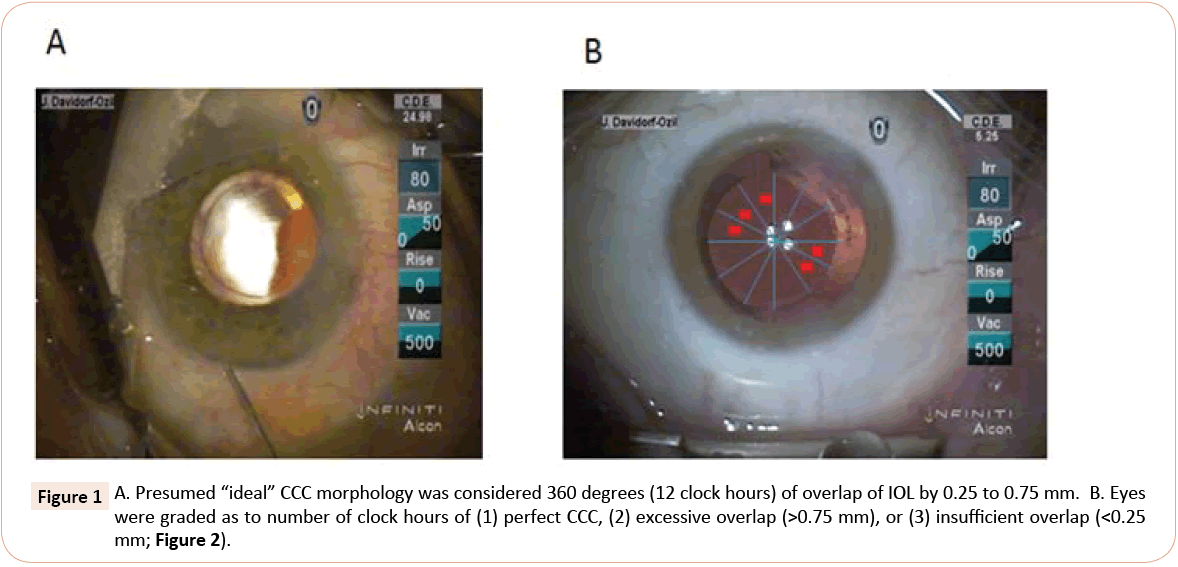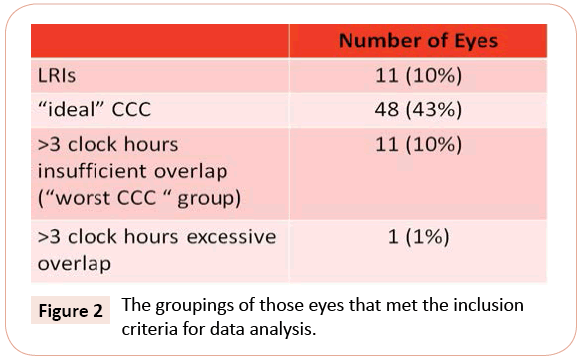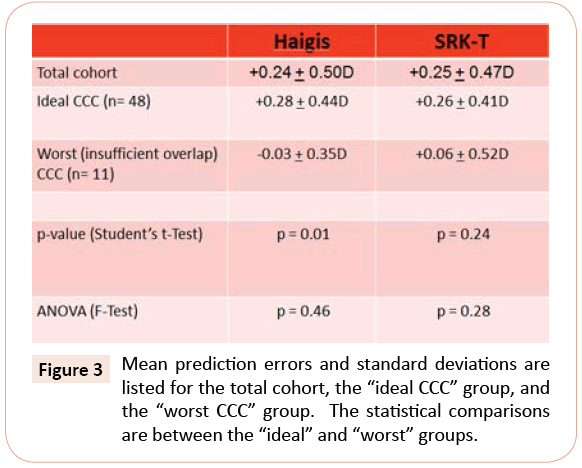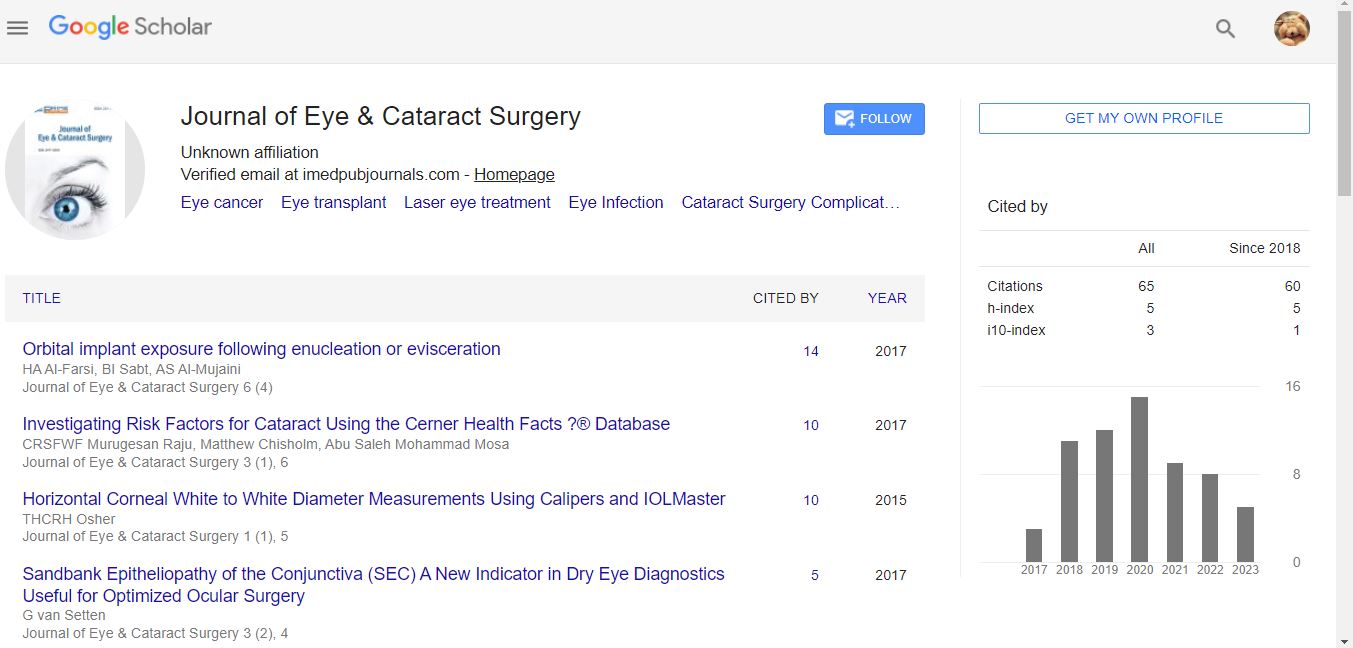Jonathan M Davidorf*
Davidorf Eye Group, Stein Eye Institute, Los Angeles, CA, 44514, USA
*Corresponding Author:
Jonathan M Davidorf
Davidorf Eye Group, Stein Eye Institute, Los Angeles, CA, 44514, USA
E-mail: DrJ@davidorf.com
Received Date: October 02, 2015 Accepted Date: December 28, 2015 Published Date: December 30, 2015
Citation: Davidorf JM (2016) Impact of Capsulorhexis Morphology on the Predictability of Intraocular Lens Power Calculations. J Eye Cataract Surg 1:7. doi: 10.21767/2471-8300.100007
Copyright: © 2016 Davidorf JM, et al. This is an open-access article distributed under the terms of the Creative Commons Attribution License, which permits unrestricted use, distribution, and reproduction in any medium, provided the original author and source are credited.
Keywords
Intraocular Lens; Capsulorhexis; Power
Introduction
Since the introduction of the continuous curvilinear capsulorhexis (CCC), recommendations have been offered as to the optimal size of the capsulotomy relative to the intraocular lens (IOL) optic [1,2]. While the preferred amount of capsulorhexis-IOL overlap may vary from surgeon to surgeon and may depend on the IOL model implanted, a CCC with 360° of optic overlap is commonly recommended [3-5]. Excessive overlap may cause a postoperative hyperopic shift and incomplete overlap has been associated with IOL tilt [6-10]. The arrival of femtosecond assisted cataract surgery brings the promise of the perfect capsulorhexis. There are abundant claims (multiple personal communications and some published data) that a perfect capsulorhexis will improve outcomes [11-14]. The hypothesis is that, even compared to acceptably shaped CCCs, a perfectly centered, perfectly round anterior capsulotomy will improve the predictability of the effective lens position. To date, the data have been mixed, and even when differences in refractive outcomes have been reported, the differences have been subtle [15-18]. For example, in their study of 134 eyes, Filkorn et al. demonstrated no statistically significant difference in mean error but a “subtle” statistically significant difference in mean absolute error when comparing refractive outcomes of femtosecond cataract surgery and conventional cataract surgery. Six different IOL models were used in this cohort, and no discussion about the refractive outcomes with the various IOL models was presented, making this study difficult to interpret. Studying 90 eyes, Mastropasqua et al. concluded that the laser capsulotomy groups (two groups) and manual capsulotomy group had similar refractive outcomes at one week and one month, but that there was a statistically significant difference in spherical equivalent at 6 months (favorable for the laser groups). Interestingly, the measure of refractive predictability, the variance, appeared favorable for the manual group, although this was not discussed in the report (the difference was not likely statistically significant). A recent report by Okada et al. of 113 eyes undergoing cataract surgery with a manual capsulotomy in a teaching hospital clinical setting found no relationship between capsulorhexis morphology and refractive outcomes, although refractive stability appeared to be negatively impacted by incomplete optic overlap [19]. The purpose of the present study is to investigate the impact of capsulorhexis (CCC) morphology on predictability of intraocular lens (IOL) calculations following routine cataract surgery by a single, experienced surgeon, using a novel, simple method for describing CCC morphology.
Materials and Methods
The study is HIPAA (Health Insurance Portability and Accountability Act) compliant, and per the Health and Human Services common rule definitions of Human Subjects, Institutional Review Board (IRB) approval was not required [20]. The research reported herein adheres to the tenets of the Declaration of Helsinki. This is a retrospective, observer masked study in which 175 consecutive cataract surgery videos were reviewed. All eyes had topical anesthesia, a 2.4 mm clear corneal incision (sutureless), a manual CCC (with capsulorhexis forceps), phacoemulsification with the Infinity System (Alconlabs, Fort Worth, Texas), and implantation of a foldable intraocular lens implant by a single surgeon (JMD). The observer (JMD) was masked as to surgical outcome. CCC morphology in relation to IOL position was graded. Presumed “ideal” CCC morphology was considered 360 degrees (12 clock hours) of overlap of the IOL by 0.25 mm to 0.75 mm. Eyes were graded as to number of clock hours of (1) perfect overlap, (2) excessive overlap (>0.75 mm), or (3) insufficient overlap (<0.25 mm; Figure 1). Subject eyes were placed in the “ideal” CCC group if 12 clock hours (360 degrees) of ideal CCC overlap of the IOL. Eyes with more than 3 clock hours of insufficient CCC overlap (<0.25 mm) were placed in the “insufficient overlap” group, and eyes with more than 3 clock hours of excessive CCC overlap (>0.75 mm) were placed in the “excessive overlap” group. The plan was to ultimately compare the “ideal” CCC group with the two “worst” CCC groups (“insufficient overlap” and “excessive overlap” groups). Only eyes receiving an aspheric acrylic monofocal IOL (SN60WF; Alconlabs, Fort Worth, Texas) were included for data analysis. Because the main outcomes measure was refractive accuracy of the IOL calculations, the other inclusion criteria for data analysis were postoperative corrected visual acuity of 20/40 or better and no prior history of refractive, corneal, glaucoma, or retinal surgery. Eyes with visually significant ocular comorbidities were also excluded from data analysis. Because limbal relaxing incisions do not affect spherical equivalent refractions [21-24], eyes that had LRIs performed at the time of the cataract surgery were included for data analysis. For each subject eye, prediction errors from one month postoperative manifest refractions were calculated from the difference of the manifest refraction spherical equivalent (MRSE) and the predicted MRSE from the the SRK-T (not surgeon optimized) and Haigis (previously optimized to give a numerical mean error of zero) IOL calculation formulae [25,26]:

Figure 1: A. Presumed “ideal” CCC morphology was considered 360 degrees (12 clock hours) of overlap of IOL by 0.25 to 0.75 mm. B. Eyes were graded as to number of clock hours of (1) perfect CCC, (2) excessive overlap (>0.75 mm), or (3) insufficient overlap (<0.25 mm; Figure 2).
Prediction Error=Postoperative MRSE-Formula Predicted SE
In order to highlight the potential impact of CCC morphology on IOL calculation predictability, the mean prediction errors and variances were to be compared between the “ideal group” and the least ideal (“worst”) groups (“insufficient overlap” and “excessive overlap” groups) using the Student’s t-Test and ANOVA (F-Test).
Results
Of the 175 surgical videos reviewed, 112 subject eyes met the inclusion criteria for data analysis. Of the 63 eyes that did not meet the inclusion criteria for data analysis, 47 eyes (27%) received an aspheric acrylic apodized multifocal IOL (SN6AD1; Alconlabs, Fort Worth, Texas), 13 eyes (12%) received an aspheric acrylic toric IOL (SN6AT; Alconlabs, Fort Worth, Tx), 1 eye (1%) received a multifocal acrylic IOL (ZMB00; Abbott Medical Optics, Santa Ana, CA), and two eyes received the SN60WF but had reduced postoperative best spectacle corrected visual acuity of <20/40 because of maculopathy. Of the 112 eyes that met the inclusion criteria for data analysis, 48 (43%) were in the “ideal” group, 11 (10%) in the “insufficient overlap” group, and 1 eye (1%) in the “excessive overlap” group (Figure 2). Eleven eyes (10%) had LRIs performed – 5 eyes (10%) in the “ideal” group and 1 eye (9%) in the “insufficient overlap” group. The one eye in the “excessive overlap” group did not have an LRI performed. Because there was only one eye that qualified for inclusion in the “excessive overlap group,” the statistical comparisons were performed on the “ideal” and “insufficient overlap” groups. Figure 3 shows that the lowest mean prediction error was seen with “insufficient overlap” group using the Haigis IOL calculation formula. This difference was statistically significant (p=0.01). The lowest standard deviation was found in the same group, but this difference was not statistically significant (p=0.46). The prediction errors for the one eye in the “excessive overlap” group were -0.33D (Haigis) and -0.07D (SRK-T).

Figure 2: The groupings of those eyes that met the inclusion criteria for data analysis.

Figure 3: Mean prediction errors and standard deviations are listed for the total cohort, the “ideal CCC” group, and the “worst CCC” group. The statistical comparisons are between the “ideal” and “worst” groups.
Discussion
Interestingly, the lowest mean prediction error was seen in the worst CCC group (“insufficient overlap”). The difference was only statistically significant for the Haigis formula, with a p-value 0.01. The most important measure of IOL calculation formula predictability is the variance (nomogram adjustments can accurately be made if the spread of the data is low), and no statistically significant difference could be identified between the “worst” and “ideal” CCC groups in this regard. By comparing the eyes with very little to no CCC overlap of the IOL to those eyes with “ideal’ CCC morphology, the thought was that, if differences in IOL power calculation predictability exist, this comparison should demonstrate the difference. Certainly it is possible that differences would be apparent if larger numbers of eyes with longer follow-up were studied. However, if a statistically significant difference in the variances can only be found, hypothetically, in a much larger cohort than 112 eyes, is creating the “ideal CCC” even clinically relevant? It is also possible that the pre-study assumptions of “ideal” CCC morphology are wrong and that there is, instead, some other CCC morphology that is, in fact, the ideal one for IOL power calculation predictability. The method of describing CCC morphology is simple and easily reproducible by other surgeon investigators without the need for sophisticated geometry formulas or computer programs. It is possible, however, that other methods of describing CCC morphology would yield different outcomes. It was notable how few eyes were categorized as having the “worst” CCC morphology, considering that these surgeries were performed prior to initiating (and even planning) the study. It would be interesting to examine how consistently an “ideal” CCC morphology could be achieved, manually, if the surgeon were to consciously strive to achieve that specific goal. Presumably, such a goal could be achieved in more than the 43% of eyes seen in this study. Optical zone markers, calipers or novel devices can be used as a guide/template when constructing the CCC, but the results of this study do not make a compelling argument in favor of taking extra steps in an attempt to improve IOL calculation predictability [27,28]. From a safety standpoint, out of the 175 consecutive surgical cases reviewed, there were no cases of truly aberrant CCCs (i.e., anterior capsule tears) or posterior capsule ruptures. It should also be noted that, when reviewing the surgical video footage, there were cases that seemed to have perfectly sized and centered CCC but wound up having less than “ideal” CCC overlap of the IOL. In other words, simply because a CCC looks perfect prior to initiating lens removal, it does not necessarily follow that the IOL’s center will align with the center of a seemingly perfect CCC. This issue would be expected to arise whether a CCC is created manually or with a femtosecond laser. In conclusion, the data suggest that there is no relationship between capsulorhexis morphology (within the range of capsulorhexis morphologies studied) and refractive outcomes in cataract surgery. Inasmuch as differences were not evident between “ideal” and “worst” CCC groups, if differences do, in fact, exist, they very well may be subtle.
References
- Gimbel HV, Neuhann T (1990)Development, advantages, and methods of the continuous circular capsulorhexis technique.J Cataract Refract Surg16:31-37.
- Thomas O, et al.Phacoemulsification, capsulorhexis, and intraocular lens power prediction accuracy.J Cataract Refract Surg 19: 695-699.
- Chang DF (2004) Strategies for difficult capsulorrhexis.In: Chang DF (ed.)Phaco Chop; Mastering Techniques, Optimizing Technology and Avoiding Complications. Thorofare, NJ, Slack, pp.143-161.
- Ravalico G, Tognetto D, Palomba MA, et al. (1996) Capsulorhexis size and posterior capsule opacification. J Cataract Refract Surg22:98-103.
- Hollick EJ, Spalton DJ, Meacock WR (1999)The effect of capsulorhexis size on posterior capsular opacification: one-year results of a randomized prospective trial. Am J Ophthalmol128:271-279.
- Mutlu FM, Bilge AH, Altinsoy HI, Yumusak E (1998)The role of capsulotomy and intraocular lens type on tilt and decentration of polymethylmethacrylate and foldable acrylic lenses. Ophthalmologica212: 359-363.
- Vargas LG, Auffarth GU, Becker KA, Rabsilber TM, Holzer MP(2005) Performance of the 1CU accommodating intraocular lens in relation to capsulorhexis size J Cataract Refract Surg31:363-368.
- Tassignon MJ, Rozema JJ, Gobin L (2006)Ring-shaped caliper for better anterior capsulorhexis sizing and centration.J Cataract Refract Surg 32: 1253-1255.
- Sanders DR, Higginbotham RW, Opatowsky IE, Confino J (2006) Hyperopic shift in refraction associated with implantation of the single-piece Collamer intraocular lens. J Cataract Refract Surg32:2110-2112
- Torquetti L (2015) Toric intraocular lens rotation related to the capsulorhexis. J Cataract Refract Surg41:483.
- He L, Sheehy K, Culbertson W (2011) Femtosecond laser-assisted cataract surgery. CurrOpinOphthalmol. 22:43-52.
- Friedman NJ, Palanker DV, Schuele G (2011) Femtosecond laser capsulotomy. J Cataract Refract Surg37:1189-1198.
- Tackman RN, Kuri JV, Nichamin LD, Edwards K (2011)Anterior capsulotomy with an ultrashort-pulse laser. J Cataract Refract Surg37:819-824.
- Izak AM, Werner L, Pandey SK, Apple DJ (2004) Analysis of the capsule edge after Fugo plasma blade capsulotomy, continuous curvilinear capsulorhexis, and can-opener capsulotomy.J Cataract Refract Surg.30:2606-2611.
- Filkorn T, Kovács I, Takács Á, Horváth É, Knorz MC, et al.(2012) Comparison of IOL power calculation and refractive outcome after laser refractive cataract surgery with a femtosecond laser versus conventional phacoemulsification. J Refract Surg28: 540-544.
- Mastropasqua L, Toto L, Mattei PA, Vecchiarino L, Mastropasqua A, et al. (2014) Optical coherence tomography and 3-dimensional confocal structured imaging system?guided femtosecond laser capsulotomy versus manual continuous curvilinear capsulorhexis.Journal J Cataract Refract Surg40:2035-2043.
- Abell RG, Darian-Smith E, Kan JB, Allen PL, Ewe SYP, et al. (2015) Femtosecond laser?assisted cataract surgery versus standard phacoemulsification cataract surgery: outcomes and safety in more than 4000 cases at a single center. J Cataract Refract Surg41: 47-52.
- Davidorf JM (2015) Femtosecond versus (gold) standard phacoemulsification.J Cataract Refract Surg.41:1124.
- Okada M, Hersh D, Paul E, van der Straaten D (2014) Effect of Centration and Circularity of Manual Capsulorrhexis on Cataract Surgery Refractive Outcomes.Ophthalmology121:763-770.
- Federal Policy for the Protection of Human Subjects ('Common Rule').
- Hanna KD, Jouve FE, Waring GO, Ciarlet PG (1989) Computer simulation of arcuate and radial incisions involving the corneosclerallimbus. Eye3:227-239.
- Budak K, Friedman NJ, Koch DD (1998)Limbal relaxing incisions with cataract surgery. J Cataract Refract Surg24:503-508.
- M?ller-Jensen K, Fischer P, Siepe U (1999)Limbal relaxing incisions to correct astigmatism in clear corneal cataract surgery. J Refract Surg15:586-589.
- Bayramlar H, Daglioglu MC, Borazan M (2003) Limbal relaxing incisions for primary mixed astigmatism and mixed astigmatism after cataract surgery.J Cataract Refract Surg29:723-728.
- Retzlaff JA, Sanders DR, Kraff MC (1990) Development of the SRK/T intraocular lens implant power calculation formula. J Cataract Refract Surg16: 528.
- Haigis W (2004) The Haigis formula. In:Shammas HJ editors. Intraocular Lens Power Calculations. Thorofare, NJ: Slack, pp. 41-57.
- Tassignon MJ, Rozema JJ, Gobin L (2006) Ring-shaped caliper for better anterior capsulorhexis sizing and centration.J Cataract Refract Surg32:1253-1255.
- Lee YE, Joo CK (2015) Open ring-shaped guider for circular continuous curvilinear capsulorhexis during cataract surgery.J Cataract Refract Surg41:1349-1352.




